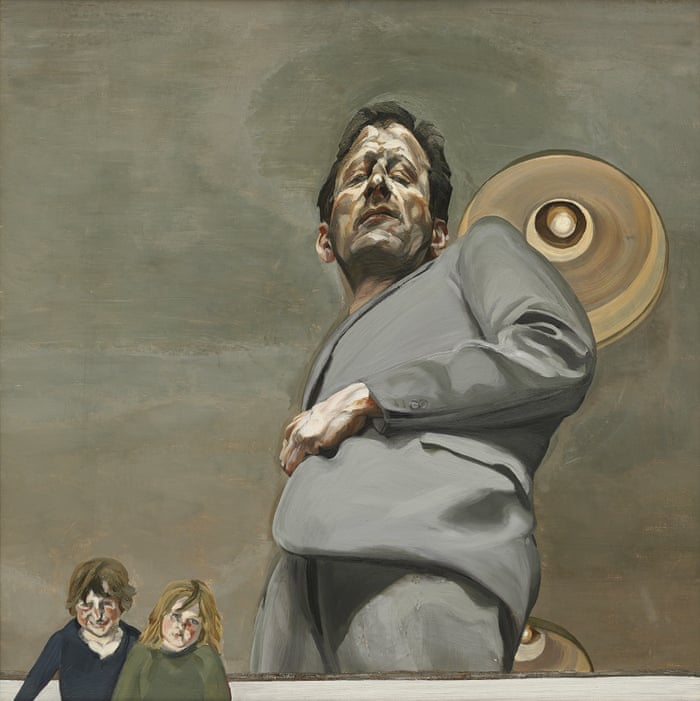
Lucian Freud: The Self-Portraits review – menacing, elusive ... orgasmic?
Royal Academy, London
Whether he’s just a shadow or staring at us, open-mouthed and wide-eyed, the great self-dramatist remains curiously unknowable
Adrian Searle
Open-mouthed and surprised, he draws himself with soft black crayon and pencil in a deceptively plain 1948 image. The caption talks about some Rembrandt etchings from 1630 and Courbet’s 1843 self-portrait The Desperate Man. Instead, I see a young man wide-eyed in orgasm, his head tilted slightly back, the chin closer to us than his forehead. Who’s on top? Is anybody there? There is shading around the edge of his ears and his neck, as if he were pressed against a pillow. Maybe he is imagining what he would look like in that instant to a lover. Behind Freud’s teeth his mouth is a black cavern that could swallow the world. I imagine it going all the way down, but maybe that’s just me.
 Self-portrait, Reflection, 2002
Self-portrait, Reflection, 2002
Once, he’s only a shadow, cast on the bed where his model lies naked. Like a stain or trace evidence, this looming, enlarged patch of grey on the sheet almost isn’t there, while everything else in the painting is solid; the woman on the bed is raw and fleshy. This shadow puts us in the painter’s place, hovering invisible over a naked woman. It looks like a movie murder scene; I think of Sickert and of Alfred Hitchcock’s Frenzy. A section of this exhibition is devoted to works in which Freud’s own presence is secondary: a pair of small self-portraits sit at the bottom of a wall in the background to his portrait of two Irishmen in their suits. My eye wanders past and out of the window in the background to the open-skied views of west London’s stuccoed streets and tower blocks beyond. Is he misdirecting us?
 Hand Mirror on Chair, 1966
Hand Mirror on Chair, 1966
These glimpses are always more than incidental, even when all we see are Freud’s pacing shoes beyond his sitter, caught in the studio mirror as he turns between the canvas and his model. You think you hear the sound of his feet. And then you see a bit of his leg, reflected dim in the night-time window between the blind and the sill, as his son Freddy, naked and stark, stands in the corner of the room.
Sometimes he is cropped and sometimes he is unfinished, his face petering out into smears and lost brushstrokes. In their way, these false starts are as complete as any portrait gets. He is always beginning again. “When I see photographs of painters staring into the distance I always think, ‘What complete cunts. I don’t want to be one of those,’” Freud once remarked. I don’t think he wanted to be one of those painters who portray themselves all constipated and brow-furrowing, smug and supercilious, either. Even when he is at the centre of things, he’s unknowable.
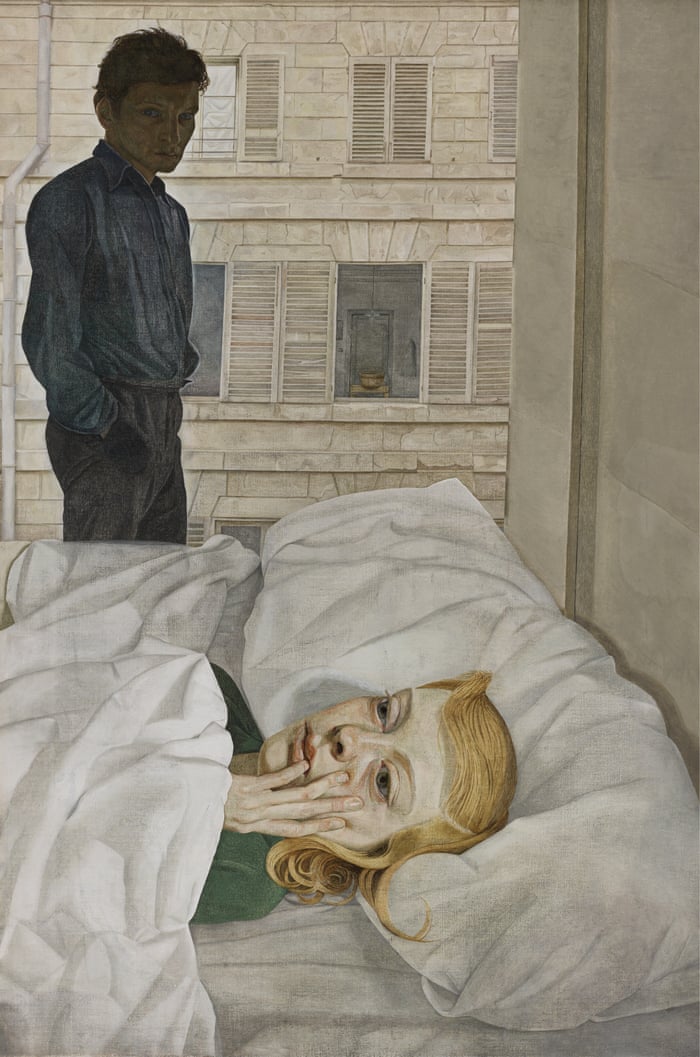 Hotel Bedroom, 1954
Hotel Bedroom, 1954
Freud is a great self-dramatist, and seems to take pleasure catching snatches of himself in mirrors, peering between the foliage of a potted plant, looming and menacing like a 1960s London gangster, then suave and louche, or a sly old git, fixing us from the corner of his eye with a horrible knowing glance as he passes by.
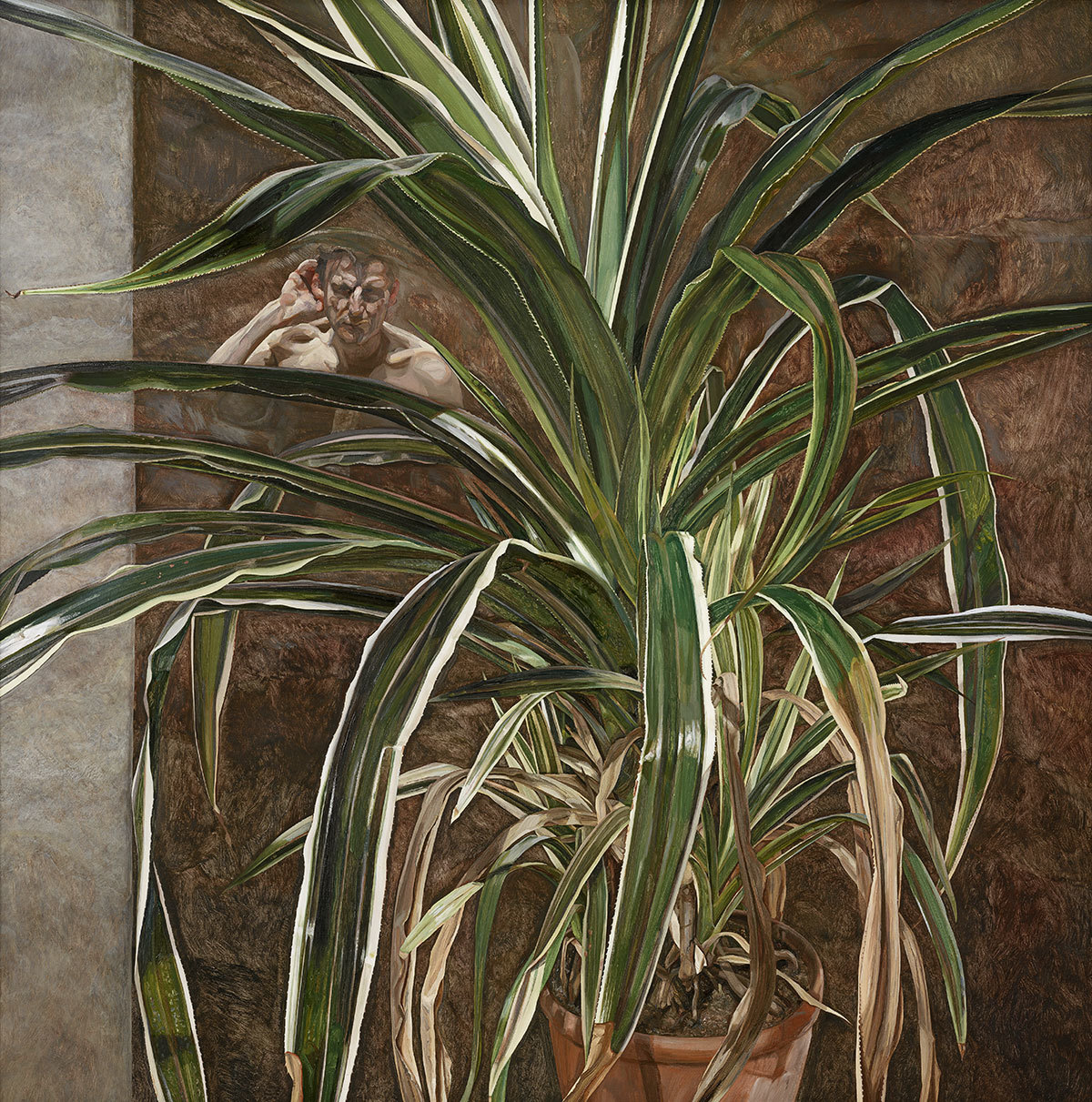 Interior with Plant, Reflection Listening, (Self-portrait), 1967-68
Interior with Plant, Reflection Listening, (Self-portrait), 1967-68
Freud may have resisted his grandfather Sigmund’s influence on his own paintings, but both worked in self-consciously contrived stage-set rooms where other people come and go, leave and return and have secrets to tell. In Freud’s paintings the secrets are the one’s the body tells, rather than the things they say. How complicated, how fascinating it all is.
Lucian Freud: The Self-Portraits is at the Royal Academy, London, from 27 October to 26 January.
https://www.theguardian.com/artanddesign/2019/oct/22/lucian-freud-the-self-portraits-review-royal-academy-london
Royal Academy, London
Whether he’s just a shadow or staring at us, open-mouthed and wide-eyed, the great self-dramatist remains curiously unknowable
Adrian Searle
The Guardian
22 Oct 2019
Lucian Freud at 18, his head ballooning out of the frame, flat-faced, a glint in his liquid eye where the light catches the varnish. His eyebrows are millipedes. Then Lucian in 1943, big-eared, gawky, oddly calm, a white feather in his hand.
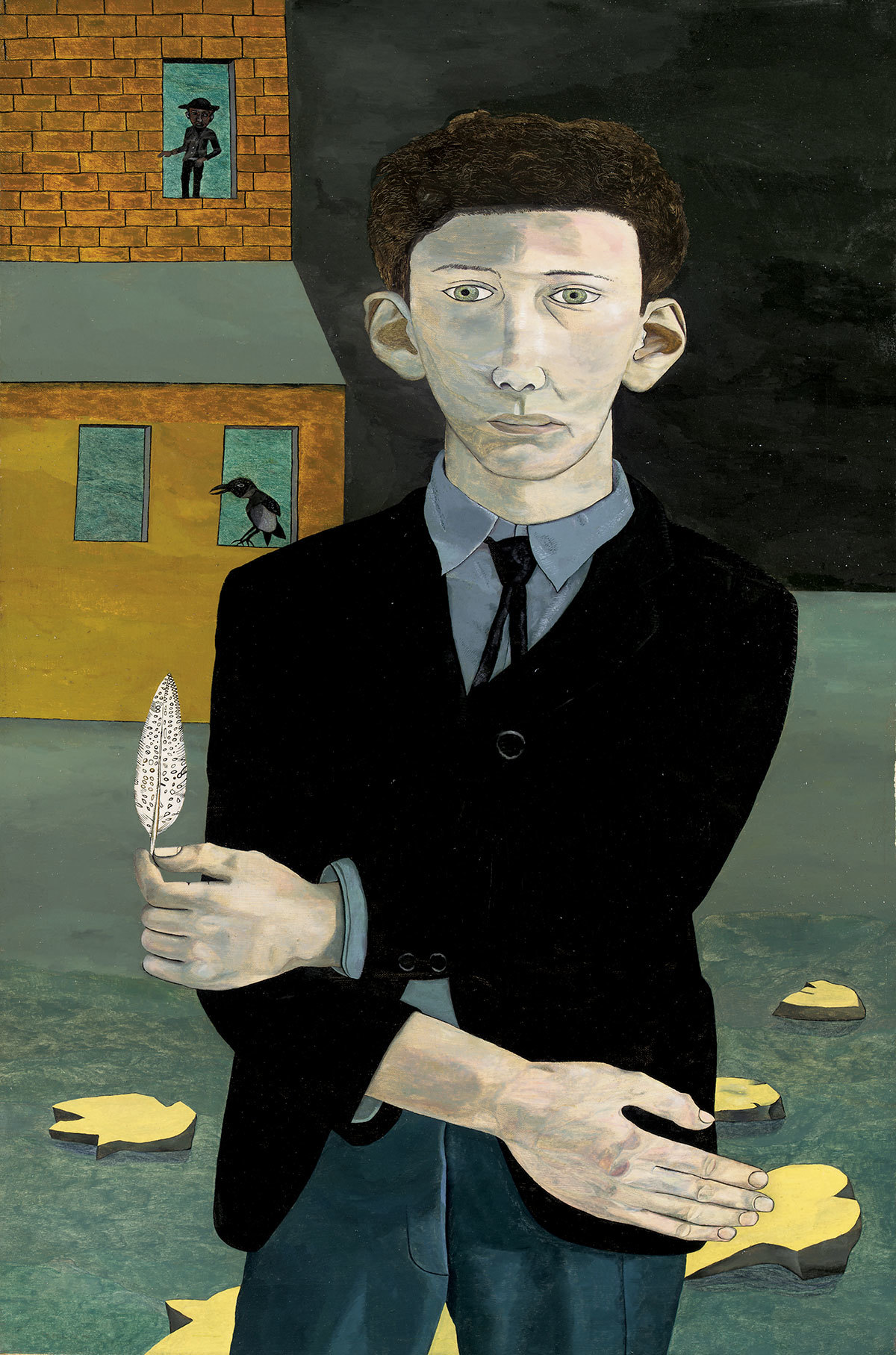
Man with a Feather, 194322 Oct 2019
Lucian Freud at 18, his head ballooning out of the frame, flat-faced, a glint in his liquid eye where the light catches the varnish. His eyebrows are millipedes. Then Lucian in 1943, big-eared, gawky, oddly calm, a white feather in his hand.

With each work in this exhibition of Freud’s self-portraits we witness an increasing occupation with his own portrayal, the person moving in and taking up residence in his own unstable image – the one he’s been given and the one he’s making for himself. Sometimes we see Freud in glimpses, or peering round a corner, uneasy but knowing. Then he’s hanging about by a streetlamp, beside a wall surrounding a big house. I hear a lonesome harmonica, and imagine him reaching into his pocket for a packet of Strand cigarettes. (“You’re never alone with a Strand,” the advert went.)
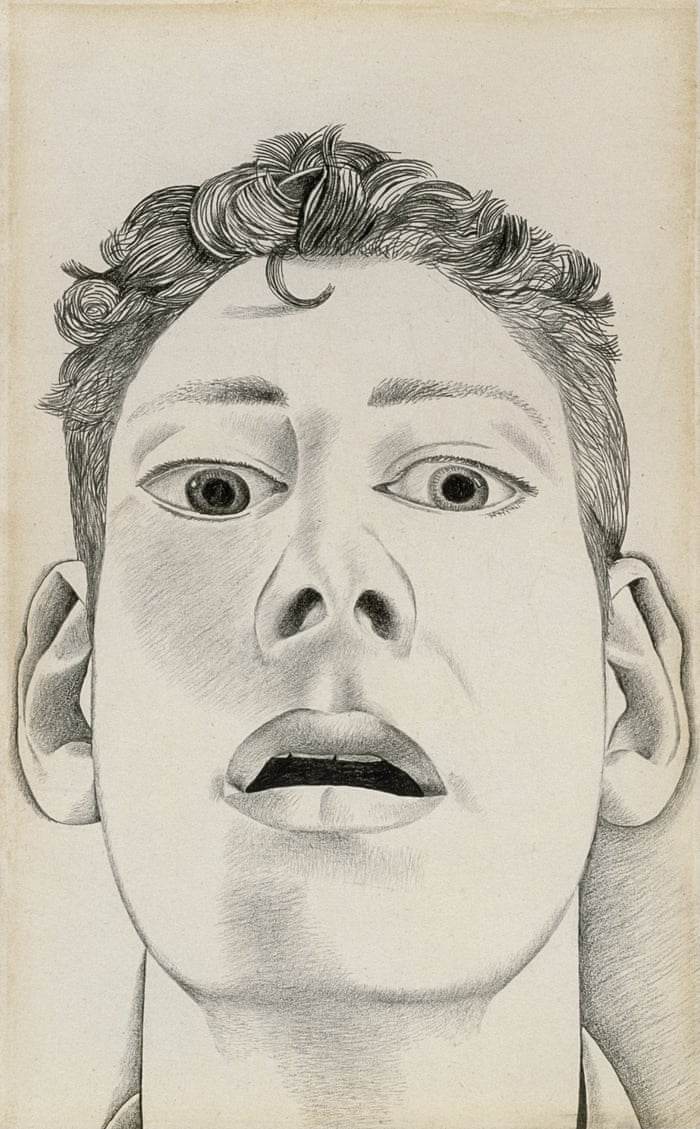
Startled Man: Self Portrait, 1948
Open-mouthed and surprised, he draws himself with soft black crayon and pencil in a deceptively plain 1948 image. The caption talks about some Rembrandt etchings from 1630 and Courbet’s 1843 self-portrait The Desperate Man. Instead, I see a young man wide-eyed in orgasm, his head tilted slightly back, the chin closer to us than his forehead. Who’s on top? Is anybody there? There is shading around the edge of his ears and his neck, as if he were pressed against a pillow. Maybe he is imagining what he would look like in that instant to a lover. Behind Freud’s teeth his mouth is a black cavern that could swallow the world. I imagine it going all the way down, but maybe that’s just me.

Once, he’s only a shadow, cast on the bed where his model lies naked. Like a stain or trace evidence, this looming, enlarged patch of grey on the sheet almost isn’t there, while everything else in the painting is solid; the woman on the bed is raw and fleshy. This shadow puts us in the painter’s place, hovering invisible over a naked woman. It looks like a movie murder scene; I think of Sickert and of Alfred Hitchcock’s Frenzy. A section of this exhibition is devoted to works in which Freud’s own presence is secondary: a pair of small self-portraits sit at the bottom of a wall in the background to his portrait of two Irishmen in their suits. My eye wanders past and out of the window in the background to the open-skied views of west London’s stuccoed streets and tower blocks beyond. Is he misdirecting us?

These glimpses are always more than incidental, even when all we see are Freud’s pacing shoes beyond his sitter, caught in the studio mirror as he turns between the canvas and his model. You think you hear the sound of his feet. And then you see a bit of his leg, reflected dim in the night-time window between the blind and the sill, as his son Freddy, naked and stark, stands in the corner of the room.
Sometimes he is cropped and sometimes he is unfinished, his face petering out into smears and lost brushstrokes. In their way, these false starts are as complete as any portrait gets. He is always beginning again. “When I see photographs of painters staring into the distance I always think, ‘What complete cunts. I don’t want to be one of those,’” Freud once remarked. I don’t think he wanted to be one of those painters who portray themselves all constipated and brow-furrowing, smug and supercilious, either. Even when he is at the centre of things, he’s unknowable.

Freud is a great self-dramatist, and seems to take pleasure catching snatches of himself in mirrors, peering between the foliage of a potted plant, looming and menacing like a 1960s London gangster, then suave and louche, or a sly old git, fixing us from the corner of his eye with a horrible knowing glance as he passes by.

Life, like painting, is a kind of self-invention, but along the way things intervene. Shit happens to us and around us, in paintings as well as life. Accidents and mistakes pile up – just like that thick, granular and poisonous lead-white Freud used in his later work. The mistakes and accidents include other people, their presence and affect as they pass through the studio. Their bodies, clothed or naked, are always in the way.
Hell isn’t only other people. One must include oneself and one’s body in this comedy of errors and terrors and that’s what Freud does. Then, later, naked in the studio, he raises his palette knife aloft with a kind of comic defiance. Along with the sallow, sagging skin, he is a mess of revisions and repaintings, the pigment piling up and moiling over his cock and balls, the face redone and done again, the room emptying out behind him. It is only him there now.
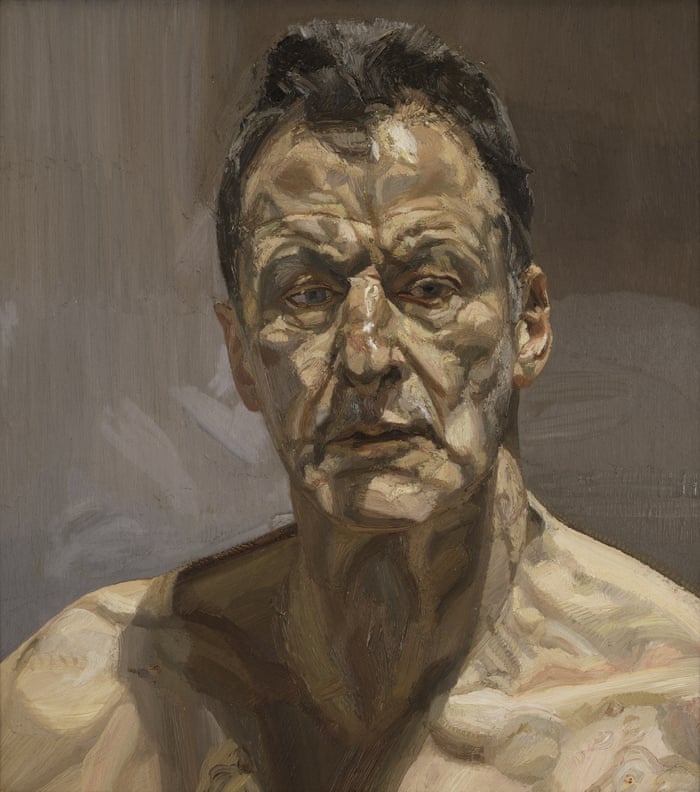
Hell isn’t only other people. One must include oneself and one’s body in this comedy of errors and terrors and that’s what Freud does. Then, later, naked in the studio, he raises his palette knife aloft with a kind of comic defiance. Along with the sallow, sagging skin, he is a mess of revisions and repaintings, the pigment piling up and moiling over his cock and balls, the face redone and done again, the room emptying out behind him. It is only him there now.

Reflection (Self Portrait), 1985
Freud may have resisted his grandfather Sigmund’s influence on his own paintings, but both worked in self-consciously contrived stage-set rooms where other people come and go, leave and return and have secrets to tell. In Freud’s paintings the secrets are the one’s the body tells, rather than the things they say. How complicated, how fascinating it all is.
Lucian Freud: The Self-Portraits is at the Royal Academy, London, from 27 October to 26 January.
https://www.theguardian.com/artanddesign/2019/oct/22/lucian-freud-the-self-portraits-review-royal-academy-london









No comments:
Post a Comment